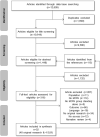The Nutritional Issue of Older People Receiving Home-Delivered Meals: A Systematic Review
- PMID: 33763442
- PMCID: PMC7982843
- DOI: 10.3389/fnut.2021.629580
The Nutritional Issue of Older People Receiving Home-Delivered Meals: A Systematic Review
Abstract
Background: Setting up a home-delivered meal service often allows older people suffering from physical and/or cognitive disabilities to stay at home. However, older people who delegate their food activities (food purchasing, cooking…) have been reported to have a worse nutritional status than people who take care of their food activities. In this context, we will conduct a systematic review of all studies related to the nutritional issue in home-delivered meal older recipients. Methods: In June 2020, we searched 3 databases (Pubmed, Web of Science, EMBASE) to identify studies from all years on older adults at home and receiving home-delivered meal services (population). The following outcomes were considered: nutritional status (Body Mass Index, weight, undernutrition) and nutritional intake. Any nutritional intervention, comparator, and study design were relevant for inclusion. Results: Forty-eight original studies met the inclusion criteria, most of them being published after the year 2000 (n = 34) and undertaken in the USA (n = 32). The selection includes 30 cross-sectional and 18 longitudinal studies. The main findings of this review are the following: (1) home-delivery meal older recipients are at high risk of undernutrition; (2) providing home-delivery meals may improve the nutritional status and nutrient intake; (3) this improvement is even higher when the home-delivery meal service is improved, for instance by providing dietetic counseling or adding supplementary snacks/meals or enriched food. However, even an improved service does not allow all the older recipients meeting their recommended nutritional allowance. Conclusion: This review reveals a need to further develop strategies allowing home-delivery meal older recipients to fulfill their nutritional needs. From a methodological point of view, there is a need to describe in more detail the home-delivered services provided to studies' participants to better consider meal frequency and meal content in the results.
Keywords: aged; body weight; food intake; malnutrition; meals-on-wheels; older adults.
Copyright © 2021 Fleury, Tronchon, Rota, Meunier, Mardiros, Van Wymelbeke-Delannoy and Sulmont-Rossé.
Conflict of interest statement
SF and PT were employed by company Saveurs et Vie. The remaining authors declare that the research was conducted in the absence of any commercial or financial relationships that could be construed as a potential conflict of interest.
Similar articles
-
Home-Delivered Meals: Characterization of Food Intake in Elderly Beneficiaries.Nutrients. 2021 Jun 16;13(6):2064. doi: 10.3390/nu13062064. Nutrients. 2021. PMID: 34208726 Free PMC article.
-
Effective elements of home-delivered meal services to improve energy and protein intake: A systematic review.Nutrition. 2020 Jan;69:110537. doi: 10.1016/j.nut.2019.06.018. Epub 2019 Jul 2. Nutrition. 2020. PMID: 31521950
-
The impact of home-delivered meal services on the nutritional intake of community living older adults: a systematic literature review.J Hum Nutr Diet. 2020 Feb;33(1):38-47. doi: 10.1111/jhn.12690. Epub 2019 Jul 2. J Hum Nutr Diet. 2020. PMID: 31266095
-
Implementing a Community-Based Initiative to Improve Nutritional Intake among Home-Delivered Meal Recipients.Nutrients. 2022 Feb 23;14(5):944. doi: 10.3390/nu14050944. Nutrients. 2022. PMID: 35267919 Free PMC article.
-
Relevance and Feasibility of a Personalized Dietary Intervention in Older People with Meals-On-Wheels: A Randomized Controlled Pilot Trial.JAR Life. 2020 Nov 19;9:40-46. doi: 10.14283/jarlife.2020.9. eCollection 2020. JAR Life. 2020. PMID: 36922924 Free PMC article.
Cited by
-
Malnutrition Risk Among the 2022 National Survey of Older Americans Act Participants: A Cross-Sectional Study.J Acad Nutr Diet. 2025 Sep;125(9):1231-1241.e9. doi: 10.1016/j.jand.2025.04.003. Epub 2025 Apr 6. J Acad Nutr Diet. 2025. PMID: 40199411
-
Home-Delivered Meals: Characterization of Food Intake in Elderly Beneficiaries.Nutrients. 2021 Jun 16;13(6):2064. doi: 10.3390/nu13062064. Nutrients. 2021. PMID: 34208726 Free PMC article.
-
Health outcomes reported by healthcare providers and clients of a community-based medically tailored meal program.BMC Nutr. 2024 Nov 4;10(1):147. doi: 10.1186/s40795-024-00955-6. BMC Nutr. 2024. PMID: 39497206 Free PMC article.
-
Tailoring registered dietitian and occupational therapy services for home-delivered meal recipients: feasibility study protocol for a randomized controlled trial.Pilot Feasibility Stud. 2025 Apr 5;11(1):41. doi: 10.1186/s40814-025-01623-7. Pilot Feasibility Stud. 2025. PMID: 40188322 Free PMC article.
References
-
- Williams I. Meals on wheels. J Home Econ. (1959) 51:763–763.
-
- Kaplan J, Williams C. Social components of Meals on Wheels Service. Gerontologist. (1961) 1:51–5. 10.1093/geront/1.1.51 - DOI
-
- Park JK, Son SM. Nutrient intakes and serum lipid profiles are improved in elderly Korean women with home food delivery. Nutr Res. (2007) 27:78–85. 10.1016/j.nutres.2006.12.007 - DOI
-
- United Nations Department of Economic and Social Affairs Population Division . World Population Prospects Highlights, 2019 Revision. (2019).
Publication types
LinkOut - more resources
Full Text Sources
Other Literature Sources
Miscellaneous


